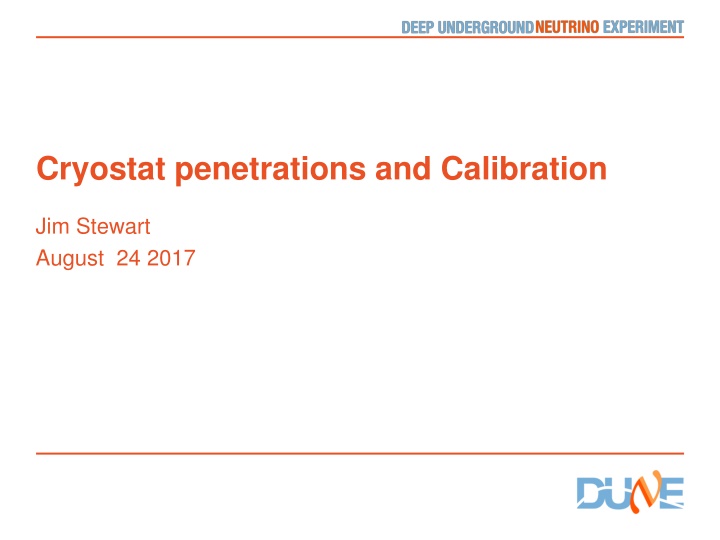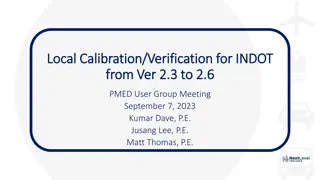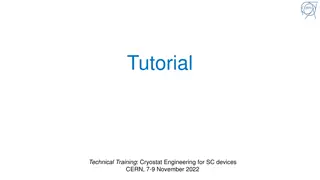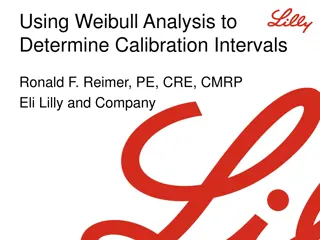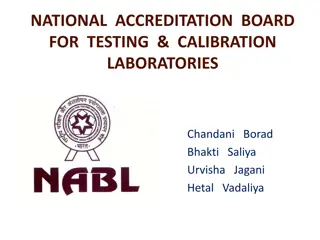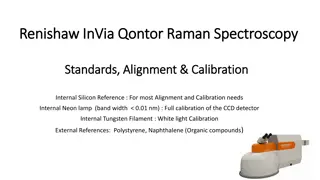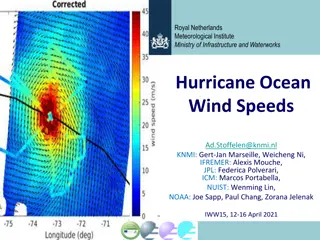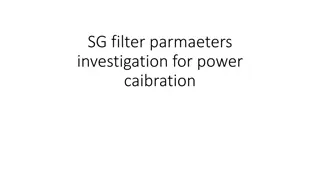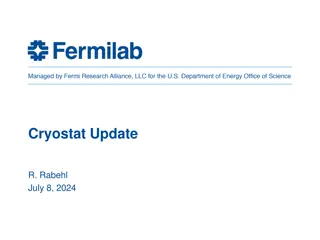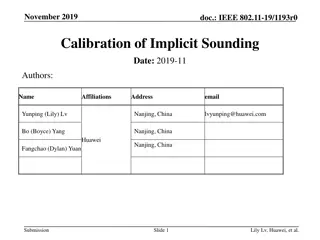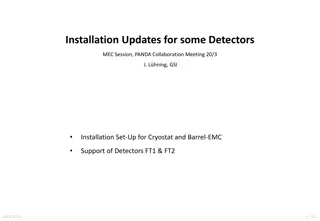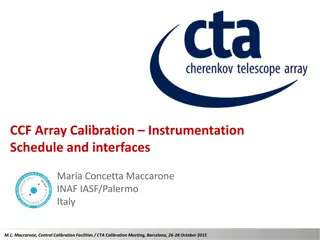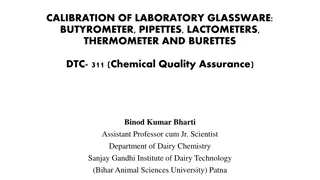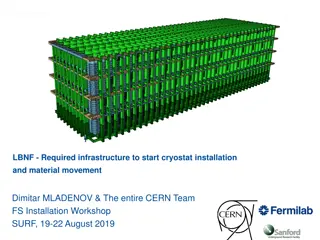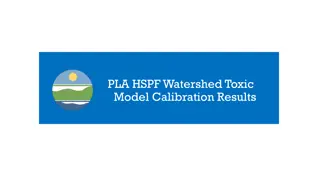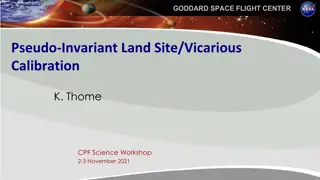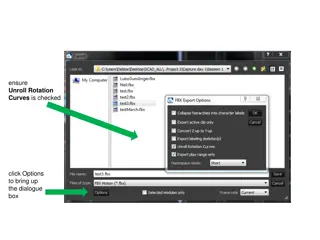Cryostat Penetrations and Calibration Study
The study focuses on minimizing the number of penetrations into the cryostat for calibration systems to reduce risks and costs. Various instrumentation feedthrus and possible systems utilizing them are discussed, including thermometry for detector monitoring. Strategies for placement and utilization of thermometers are proposed to enhance data collection.
Download Presentation

Please find below an Image/Link to download the presentation.
The content on the website is provided AS IS for your information and personal use only. It may not be sold, licensed, or shared on other websites without obtaining consent from the author.If you encounter any issues during the download, it is possible that the publisher has removed the file from their server.
You are allowed to download the files provided on this website for personal or commercial use, subject to the condition that they are used lawfully. All files are the property of their respective owners.
The content on the website is provided AS IS for your information and personal use only. It may not be sold, licensed, or shared on other websites without obtaining consent from the author.
E N D
Presentation Transcript
Cryostat penetrations and Calibration Jim Stewart August 24 2017
Work over the last few months I have tried to contact people working on the ProtoDUNE-SP calibration related systems and other people interested in the Far Detector calibration to develop a list of calibration systems and then build a coherent plan that is likely to accommodate the needed calibrations but minimized the number of penetrations into the cryostat. Information is summarized in - Calibration Concept Study Docdb 4769 - Plan for GAr and LAr monitoring Docdb 3666 2
Why to minimize the number of feedthrus Every penetration increases the risk of leaks to the LAr Every penetration increases the heat load on the cryogenic system. Each penetration adds to the complication to the cryostat roof design as the corrugation pattern needs laid out so the penetrations are in the center of the panels. The interface between the I-Beams and the corrugations makes locating any penetrations non-trivial. Each penetration adds to the engineering cost for the roof. Each penetration is adds to the cryostat and detector cost. - Higher cost of foam blocks, tubes, flanges, supports, argon purge lines, survey, 3
Present Cryostat 3D model 16 Instrumentation crossing tubes 250mm diameter. (ID or OD?) I also requested one mini-conflat for GAr purge and one CF63 for instrumentation on every feedthru. These are not in the model. Drawings are on EDMS https://edms.cern.ch/ui/#!master/navigator/document?D:1235910715:1235910715:subDocs 4
Possible Systems Utilizing the Instrumentation feedthrus 1. Thermometry 2. Purity Monitors 3. Cameras 4. Radioactive sources 5. Photon gain monitoring 6. Laser calibration system I am not going to discuss the laser system here. 5
Thermometry Thermometers are used to monitor the detector during cooldown and to provide information relevant to understanding the liquid and gas flow inside the detector. Temperature variations causing fluid flow are very small so detector sensitivity and precision will be marginal. Two schemes are considered Fixed thermometers and thermometers that can be vertically moved for cross calibration purposes. - As the APA are as close to the wall as possible there is no space to put dynamic-vertical thermometers along the wall. These can only go at the ends of the cryostat. I proposed adding a CF64 flange for 6-12 thermometers to each crossing tube so a large number of thermometers could be used if needed. The number needed to model the flow has not been studied so the real requirement is not known! 6
Cameras I did not explicitly address cameras as I considered them part of the HV group scope. However - The same CF63 ports can be used for fixed cameras or other instrumentation. - I personally like the idea of having a steerable camera that can fit into the instrumentation ports if desired. These can be pointed where you want. You can focus on what you want. The can be fixed and upgraded. It may even be interesting to look at a steerable mirror inside and a commercial telescope outside. 7
Sources Purity and Photon J rgen and Jonathan have been looking into several options for energy calibration at low energy using radioactive sources. - They desire having the capability to place sources along the ends of the detector and at several points on the roof. Zelimir has expressed an interest in a light flashing system for commissioning the photon detector and monitoring its relative gain. - The idea is to have diffusers on the cathode plane - This needs optical feedthrus for fiberoptics. The fibers are fragile and a significant number could be needed along the plane Purity monitors are useful during filling and commissioning when the TPC is not on or the purity is too low to be useful. - 35t showed that several monitors at different heights are useful. This implies the monitors need to be at the detector ends so a vertical string can be used. 8
My Proposed Configuration Increase diameter 4 new feedthrus Four crossing tubes at each end of the detector Increase diameter to >275mm ID Combine a purity monitors or dynamic vertical T-gradient monitors with a service port for each crossing tube. Essentially have a ~200 mm gate vale on the flange. The service port can be used for either radioactive sources or steerable cameras. Twelve crossing tubes distributed across the detector roof roughly half way between CPA and APA. Each with ~200mm service ports for deployable radioactive sources or steerable cameras Each with a flange to feed in Fiber optics for the photon detector The fibers could also possibly be fed through the CPA support feedthrus Each 275mm ID crossing Penetrations larger than about 300mm will be much more difficult for the cryostat design 9
Status The 16 250mm feedthrus are in the cryostat model The CF63 and mini-conflat are not but that could be simply because this part is not designed. This needs watched and I expect a the request will need defended in time. Changes to the existing model will need a change order that will need to be approved. - This needs done by the end of October as the requirements need signed off at the start of November. The technical board has the authority to propose changes. 10
